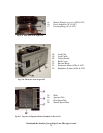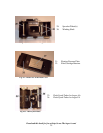Download this book for free at http://www.TheArgusA.com/
28
FA. (The Modified Two-Position Focus in Chapter 8 discusses the two-position focus
further.)
1. Focus in infinity position: To focus for a distance of about 15ft. to Infinity,
rotate the Shutter and Neck assembly until the Lens Locking Tabs are NOT over the
Locking Lugs. If done correctly, the Shutter and Neck assembly should turn freely and
not be “snapped” into place.
2. Focus in close-up position: To focus for a distance of 6ft. to about 15 ft., turn
the Shutter and Neck assembly until it locks stiffly against rotation. This allows the lens
to come forward slightly and should place the Lens Locking Tabs directly over the
Locking Lugs.
Argus AF and A2F (Variable Focus): Rotate the Focusing Ring around the
Neck of the camera until the distance in feet is aligned with the Focus Indicator. As you
turn the Focusing Ring the Shutter should move either in or out of the Neck.
Argus AA (Fixed Focus): Ensure that you are at least 6 ft. from the subject you
are photographing.
12. The method used to set the shutter speed depends on which camera you have. On
most models, the speed of the shutter is set by rotating the Face Plate until the speed
wanted is aligned with the Shutter Speed Indicator. On post-war A2Bs and all FAs, there
is a small lever that points to the desired speed. “25” means 1/25
th
of a second, “100”
means 1/100
th
of a second, etc. “T” is for timed exposure; the shutter opens when the
Trigger is pressed and remains open until the Trigger is pressed a second time. When set
at “B” (for Bulb) the shutter remains open as long as the Trigger is held down and closes
upon release. When either “T” or “B” are used the camera should be held on a tripod or
held firmly on a perfectly stationary object. The Argus AA has only two speed settings:
“Time” and “Inst.” “Time” opens the shutter as long as the Trigger is held down like the
“B” speed, not like the “T” speed. “Inst.”, meaning instantaneous, opens the shutter for
approximately 1/50
th
of a second.
13. The aperture is set by moving the Aperture Lever, which either points to the aperture
setting itself or moves the Aperture Indicator to designate the various f-stops.
CAUTION: Always check the aperture before taking a picture. This setting has a
tendency to change when the photographer is not looking.
14. If you are using an Argus AA or FA with a flash gun, ensure that it is properly
attached to the camera and has a fresh bulb. The specifications for various flash
distances, apertures, and shutters speeds depend on the type of bulb and film, so ensure
that these requirements are all satisfied. The required information is often located on the
camera’s or bulb’s exposure guide.
15. To take the picture, aim the camera by looking through the View Finder and snap the
picture by pressing the Trigger. Most cameras have a Trigger, but some (A2Fs and pre-
war A2Bs) have only a Shutter Plunger screwed into the Cable Release Port to fire the


















